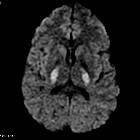Chasing the dragon






Heroin-induced leukoencephalopathy, also known as heroin-associated spongiform leukoencephalopathy, is a toxic leukoencephalopathy caused by the inhalation of heroin fumes, which is called "chasing the dragon".
Clinical presentation
Three stages are recognized:
Only a minority of patients progress through all three.
There may be a latent period with a subclinical evolution of white matter degeneration. Progression of the disease continues even after cessation of the toxin for up to 6 months.
Pathology
There is symmetric spongiform degeneration, specifically in the cerebral and cerebellar white matter as well as the corticospinal and solitary tracts.
Radiographic features
MRI
These are similar to other toxic leukoencephalopathies with widespread white matter hyperintensity involving both supra and infratentorial compartments. The characteristic distribution includes:
- symmetrical involvement of the posterior limb of the internal capsules extending inferiorly into the pontine corticospinal tracts, and superiorly into the perirolandic subcortical white matter
- subcortical U-fibers are also usually spared
- symmetrical butterfly wing pattern involvement of the cerebellar white matter
- sparing of adjacent grey matter structures
Typically regions demonstrate high DWI signal, which only sometimes represents true diffusion restriction.
MR spectroscopy
May show abnormally elevated intracerebral lactate in the affected white matter as well as decreased levels of N-acetylaspartic acid (NAA) in the white matter, gray matter, and cerebellum.
History and etymology
The following passage is from the original description in the American Journal of Roentgenology by Ciaran F. Keogh :
"The term “chasing the dragon” appears to have originated in China in the 1920s and became a popular mechanism of heroin administration in the 1950s in Hong Kong because the drug was cheap but impure. A small quantity of powder is placed on aluminum foil, which is then heated underneath with a lighter or matches. The heroin liquefies into a reddish-brown glob, which moves around on the foil and emits a white vapor. The glob or “dragon” is “chased” with the lighter underneath while the vapor is sucked through a straw or pipe..."
See also
Siehe auch:
- toxische Enzephalopathie
- symmetrische Hypodensitäten Kleinhirn
- high T2 posterior limb of internal capsule
- high T2 subcortical perirolandic cortex
- durch Heroin verursachte Hirnschäden
und weiter:

 Assoziationen und Differentialdiagnosen zu Chasing the dragon:
Assoziationen und Differentialdiagnosen zu Chasing the dragon:


